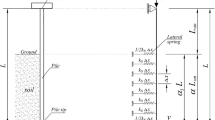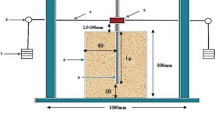Abstract
Pile instability due to buckling is considered to be one of the most important causes of superstructures failures especially in bridges and wind turbines. The mechanism of load-transfer of partially embedded piles in sand subjected to axial load to surrounded soil and the corresponding deformation are important aspects of pile design. In the present research, an experimental model was developed to measure the lateral displacement of piles subjected to axial loads. The experimental results indicated that the post buckling load of partially embedded pile was enhanced up to five times of the buckling load of free case. Two proposed formulas based on the laboratory experiments were induced to determine post buckling load of the partially embedded pile. The predicted buckling capacity of piles was compared to the experimental buckling load, which showed a good agreement.
Similar content being viewed by others
References
ASTM D422-63 (2007) Testing and materials specifications. ASTM D422-63, ASTM International, West Conshohocken, PA, USA
Avent RR, Alawady M (2005) Bridge scour and substructure deterioration: Case study. Journal of Bridge Engineering 10(3):247–254, DOI: https://doi.org/10.1061/(asce)1084-0702(2005)10:3(247)
Azizinamini A, Yakel A, Sherafati A, Taghinezhad R, Gull JH (2016) Flexible pile head in jointless bridges: Design provisions for H-piles in cohesive soils. Journal of Bridge Engineering 21(3):04015064, DOI: https://doi.org/10.1061/(asce)be.1943-5592.0000791
Azzam WR, Al Mesmary M (2010) The behavior of single subjected to surcharge loading. NED University Journal of Research VII (1):1012
Azzam WR, Basha AM (2018) Utilization of micro-piles for improving the sub-grade under the existing strip foundation: Experimental and numerical study. Innovative Infrastructure Solutions 3(1), DOI: https://doi.org/10.1007/s41062-018-0149-0
Basha A, Azzam WR (2018) Uplift capacity of single pile embedded in partially submerged sand. KSCE Journal of Civil Engineering 22(12):4882–4890, DOI: https://doi.org/10.1007/s12205-017-1715-2
Chen L, Chen Y, Shi J, Chen G (2017) Small- and large-scale model tests on the buckling property of slender pile. Marine Georesources & Geotechnology 35(8):1058–1067, DOI: https://doi.org/10.1080/1064119X.2017.1285378
El Kamash W, El Naggar H (2018) Numerical study on buckling of end-bearing piles in soft soil subjected to axial loads. Geotechnical and Geological Engineering 36:3183–3201, DOI: https://doi.org/10.1007/s10706-018-0529-4
Gabr MA, Wang J, Kiger SA (1994) Effect of boundary conditions on buckling of friction piles. Journal of Engineering Mechanics 120(6): 1392–1400, DOI: https://doi.org/10.1061/(ASCE)0733-9399(1994)120:6(1392)
Gabr MA, Wang JJ, Zhao M (1997) Buckling of piles with general power distribution of lateral subgrade reaction. Journal of Geotechnical and Geoenvironmental Engineering 123(2):123–130, DOI: https://doi.org/10.1061/(ASCE)1090-0241(1997)123:2(123)
Gouvenot D (1975) Essais de chargement et de flambement de pieux aiguilles. Annales de l’Institut Technique du Batiment et des Travaux Publics 334:25–39
Heelis ME, Pavlović MN, West RP (2004) The analytical prediction of the buckling loads of fully and partially embedded piles. Géotechnique 54(6):363–373, DOI: https://doi.org/10.1680/geot.2004.54.6.363
Jesmani M, Nabavi SH, Kamalzare M (2014) Numerical analysis of buckling behavior of concrete piles under axial load embedded in sand. Arabian Journal for Science and Engineering 39(4):2683–2693, DOI: https://doi.org/10.1007/s13369-014-0970-5
Khodair Y, Hassiotis S (2006) Buckling behaviour of single pile and pile bent in the Scotch Road Bridge. Geomechanics and Geoengineering 1(4):291–298, DOI: https://doi.org/10.1080/17486020600834621
Lee KL (1968) Buckling of partially embedded piles in sands. Journal of the Soil Mechanics and Foundations Division 94(1):255–270
Lin C, Bennett C, Han J, Parsons RL (2010) p-y based approach for buckling analysis of axially loaded piles under scoured conditions. Structures congress 2010, May 12–15, Orlando, FL, USA, DOI: https://doi.org/10.1061/41130(369)12
Lu W, Zhao D (2017) Analysis on calculated length for buckling stability of steel pipe pile based on energy method. The Open Civil Engineering Journal 11:167–175, DOI: https://doi.org/10.2174/1874149501711010167
Salama MI, Basha AM (2019) Elastic buckling loads of partially embedded piles in cohesive soil. Innovative Infrastructure Solutions 4(1), DOI: https://doi.org/10.1007/s41062-019-0198-z
Vogt N, Vogt S, Kellner C (2009) Buckling of slender piles in soft soils. Bautechnik 86(S1):98–112, DOI: https://doi.org/10.1002/bate.200910046
Acknowledgments
Not Applicable
Author information
Authors and Affiliations
Corresponding author
Rights and permissions
About this article
Cite this article
Basha, A.M. Post Buckling Behavior of Slender Piles Partially Embedded in Sand Soil under Axial Load. KSCE J Civ Eng 25, 757–767 (2021). https://doi.org/10.1007/s12205-021-0263-y
Received:
Revised:
Accepted:
Published:
Issue Date:
DOI: https://doi.org/10.1007/s12205-021-0263-y




